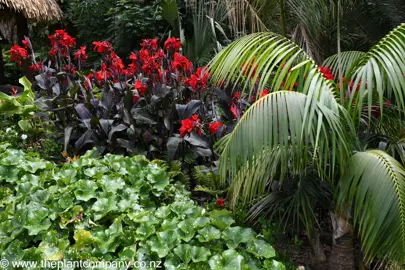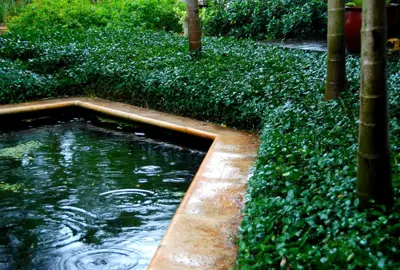Carol Mackie Daphne Bush Information
Daphne 'Carol Mackie' is a popular choice for gardens due to its attractive foliage and fragrant flowers. Some of its key characteristics include:
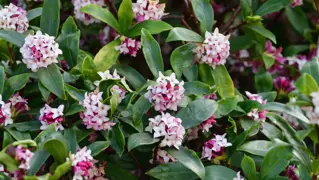
Daphne shrubs are prized for their fragrant flowers and attractive evergreen foliage, making them a popular choice in New Zealand gardens. This care guide provides essential tips on planting, watering, pruning, and managing common pests to help you cultivate healthy and beautiful Daphne plants all year round.
Choosing a Daphne plant that works for you can be challenging given the sheer number that are available. Working through the varieties, and so on, can take considerable time. The Plant Company’s series of short articles aims to offer concise and easy to follow advice and recommendations so you can determine the variety for your needs.
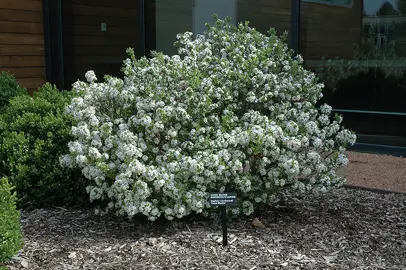
Daphne 'Carol Mackie' is a popular choice for gardens due to its attractive foliage and fragrant flowers. Some of its key characteristics include:
If you're looking for a beautiful and fragrant shrub that doesn't require a lot of maintenance, Daphne 'Carol Mackie' could be a great choice for your garden.
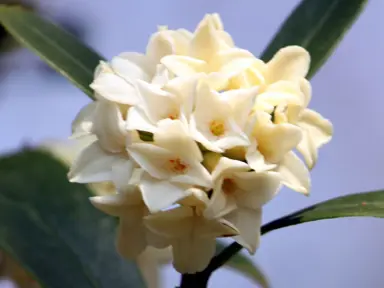
The list of Daphne that The Plant Company has worked on, propagated, and marketed is extensive. Our database of Daphne varieties is listed below:
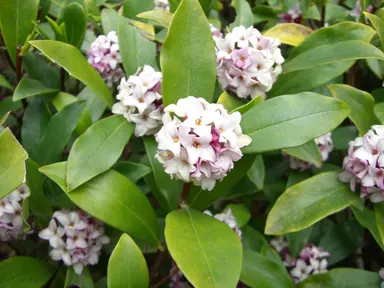
Daphne odora, also known as Winter Daphne, is a beautiful shrub with highly fragrant flowers that is native to China. It is a popular choice owing to its clusters of sweetly scented pink or white flowers in late winter to early spring, often before the leaves emerge. Some further details include:
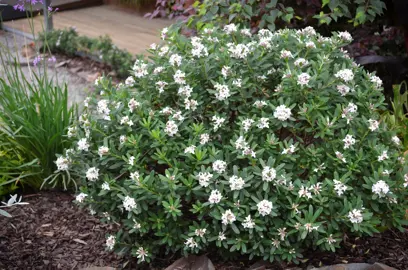
Some popular evergreen Daphne varieties include:
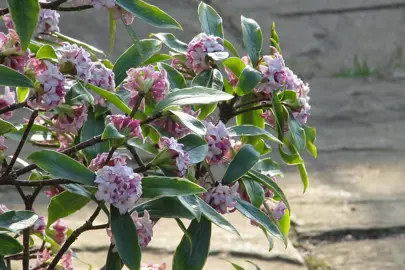
Yes, Daphne adora is the same as Daphne odora. The former is the incorrect spelling of Daphne odora.
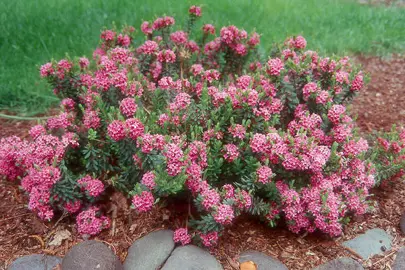
Rock Daphne (Daphne cneorum), is a beautiful evergreen shrub that's popular for its fragrant flowers and low-maintenance. Some of its key features include:
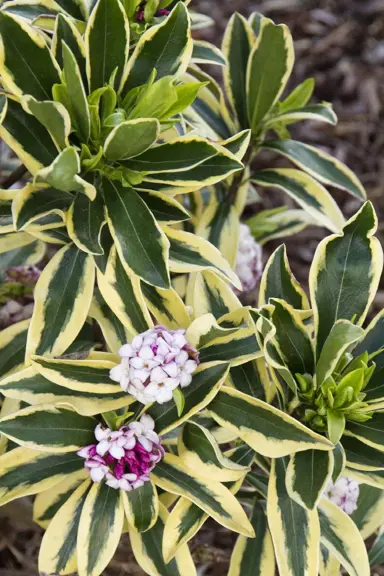
Some variegated Daphne varieties you might like for your garden:
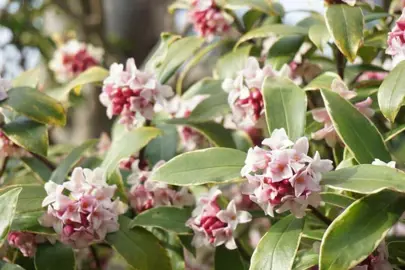
The Winter Daphne (Daphne odora) is a beautiful shrub native to China. It is popular due to its clusters of sweetly scented, pink or white flowers during late winter and early spring. The flowers often emerge before the foliage is borne.
Providing the best fertiliser for Daphne plants is important to ensure they thrive. The correct fertiliser depends on whether the plant is grown in a pot or in soil, and getting this wrong can be disastrous for your plants. Our articles provide the best advice about fertilising Daphnes so you can achieve the amazing results you are after.
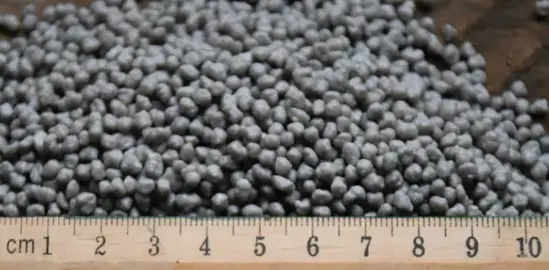
Daphne grown in containers require different fertiliser to those grown outdoors in soil. In this instance the correct fertilisers to use are either the container plant fertiliser or fertiliser tablets. Each of these will provide safe, sustained, and complete nutrition to the plant for the next 12-months. Using other types of fertiliser can be detrimental to the plant and may result in plant death.
Foliar feeding using a liquid fertiliser can be undertaken if you have time but this is not essential if container plant fertiliser or fertiliser tablets have been used. If you think the plants need an extra boost or have some yellowing, however, a liquid fertiliser application won’t hurt. A great benefit of foliar feeding is that it helps keep the leaves strong and encourages more flower buds to form as the nutrition is right where the plant needs it.
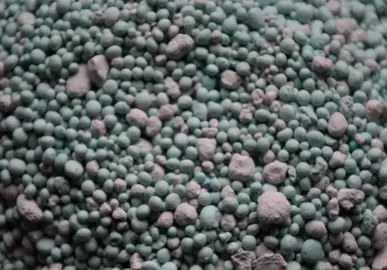
Daphne are showy plants that require feeding to keep them flowering and looking amazing. A lot of articles have all sorts of advice on this subject which often requires multiple applications, so you use more of their fertiliser. The Plant Company prefers to take a simpler and more environmentally responsible approach. Our fertiliser for acid loving plants has been specifically blended and developed to give plants an initial boost and then sustained nutrition for 12 months. This fertiliser ensures that nutrients remain in the soil around the plant rather than being lost through the soil profile to where the plant cannot reach it. This also applies to plants grown on sandy soils.
The Plant Company recommends that fertiliser for acid loving plants is applied to the soil surface in spring just as the plants start their new growth. The Plant Company also advise that no fertiliser is placed in the hole at planting, but rather spread around the soil surface so it can wash through to the roots as it releases. Do not use any lime around Daphne plants as this can cause plant damage and lead to the slow death of the plant.
Foliar feeding using a liquid fertiliser can be undertaken if you have time but this is not essential if fertiliser for acid loving plants has been applied. If you think the plants need an extra boost or have some yellowing, however, a liquid fertiliser application won’t hurt. A great benefit of foliar feeding is that it helps keep the leaves strong and encourages more flower buds to form as the nutrition is right where the plant needs it.
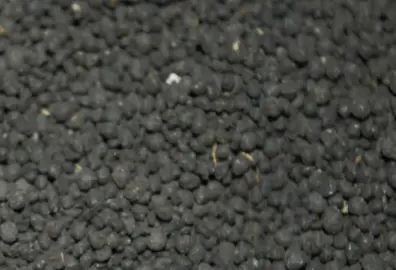
Daphne are showy plants that require feeding to keep them flowering and looking amazing. A lot of articles have all sorts of advice on this subject which often requires multiple applications so you use more of their fertiliser. The Plant Company prefers to take a simpler and more environmentally responsible approach. A suitable organic option is The Plant Company’s organic fertiliser which is applied in spring and again in autumn and will keep them well fed. You can safely apply generous amounts of this fertiliser to plants without risk of injuring the plants. More details about this fertiliser are provided with the product.
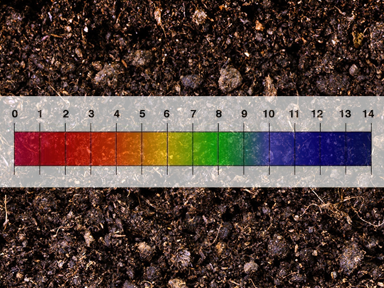
The soil pH refers to how acid of alkaline the soil is. Daphne prefer a soil pH within the range of 5.8 to 6.5 which means they like an acidic soil. As the pH of the soil moves away from this optimum range, the nutrients the plant is taking up (or not taking up) through the roots changes. If the shift in pH is too far, this can result in deficiencies of some nutrients and toxic levels of others. In either case this can cause the plant to become sick or even die a slow death.
The best way to know whether the pH is correct for your plant is to do a test. The Plant Company has pH test kits available that are easy to use and only take a few minutes to get a result. Preferably this test should be completed before planting so any pH issues can be corrected without risking the plant. A pH less 5.6 should have a sparing amounts of dolomite lime applied along with fertiliser for acid loving plants. A pH above 6.7 should have small amounts of soil acidifying fertiliser along with fertiliser for acid loving plants applied. In both instances the fertiliser should be thoroughly mixed into the soil before planting. A retest of the soil pH should be undertaken after four weeks and small adjustments made again. If the pH is in the optimum range, just use fertiliser for acid loving plants only.
This series of articles covers key questions about Daphne flowers.
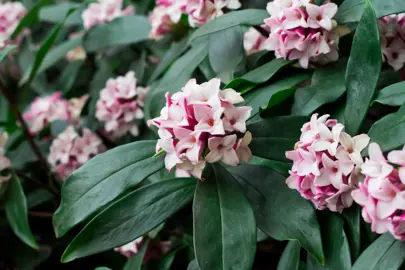
The flowering frequency of Daphne depends on the specific species:
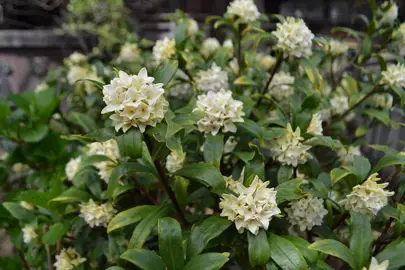
The flowering time for a Daphne depends on the variety and how well they are grown. Spring-flowering varieties will generally continue flowering until Autumn. Late winter flowering varieties produce flowers for a few weeks until spring. They will flower optimally if they have the correct soil acidity and they are not over-watered. Some articles erroneously state that under-watering is the cause of plants not to flower. This is grossly incorrect as the stress induced by plants not receiving enough water causes them to flower more. They produce more flowers as a survival mechanism to produce more seed. Therefore, if your plant is not flowering, consider reducing the watering and apply fertiliser for acid loving plants.
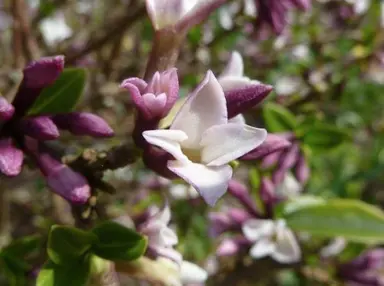
Describing the scent of a daphne flower isn't as simple as saying "it smells like roses." The fragrance of these delicate blooms is complex and layered, with different varieties offering unique olfactory experiences. However, here are some common descriptors that might give you a better idea:
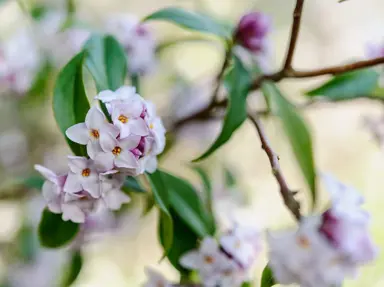
The most fragrant Daphne in New Zealand is Daphne bholua. It is a native of the Himalayas and is known for its strong, sweet fragrance. The flowers are white or pale pink and bloom in late winter to early spring. It is a relatively easy plant to care for and can be grown in a variety of climates.
Other fragrant Daphne varieties include:
This series of articles answers many of the frequently asked questions about Daphne, such as how fast they grow, their hardiness, and more!

Whether a Daphne can tolerate full sun depends on the specific variety and the climate it's growing in. Most daphne varieties prefer partial shade or dappled sunlight. This protects them from harsh midday sun, especially in hot climates. Some varieties, however, can tolerate full sun in cooler climates:
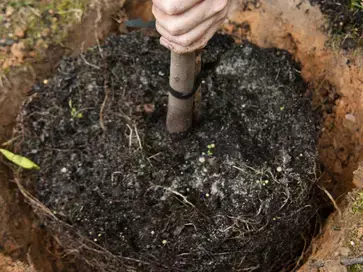
Most Daphne species have deep roots. This is one of the reasons they can be a challenge to grow in a pot. The deep root system allows them to access water and nutrients from deeper in the soil. As such, they dislike being over-watered. If you are growing a Daphne in a pot, The Plant Company recommends opting for a taller pot ahead of short option.
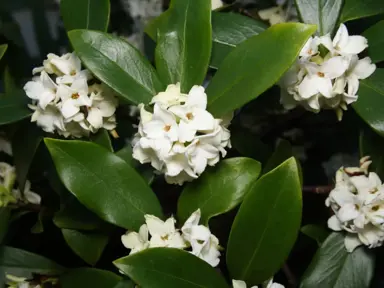
Unfortunately, Daphne is not a fast-growing shrub. In fact, it's known for being quite slow-growing, taking 7-10 years on average to reach its mature size. This can vary depending on the specific variety of daphne and the growing conditions, but it's safe to say that patience is key when it comes to these beautiful shrubs.
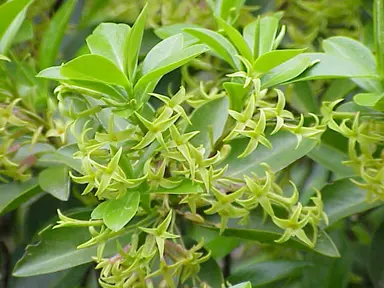
There are between 70 and 95 species of Daphne, a genus of flowering shrubs in the Thymelaeaceae family. They are native to Asia, Europe, and North Africa. These shrubs are known for their fragrant flowers and often brightly coloured berries. Two species are even used to make paper! The exact number of species can vary depending on the source, as some species are debated and may be reclassified.
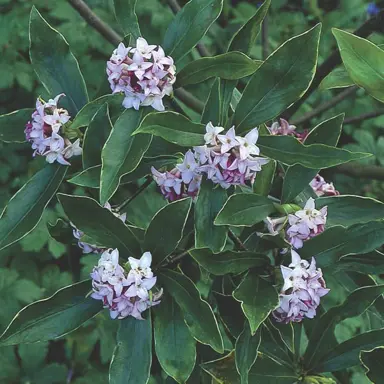
Daphines is simply the incorrect spelling of Daphne. Our expert advice pages about Daphne provide all the information you should need to know about this beautiful plant.
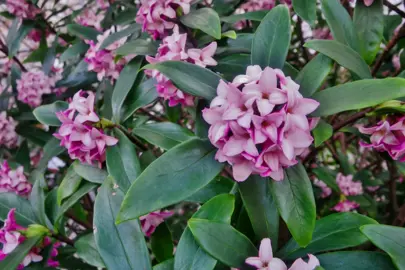
Daphn is simply the incorrect spelling of Daphne. Our expert advice pages about Daphne provide all the information you should need to know about this beautiful plant.

Yes, Daphne is poisonous to dogs. All parts of the plant, including the leaves, berries, and bark, contain toxins that can be harmful if ingested. These toxins, called daphnin and mezerein, can cause a variety of symptoms in dogs, including:
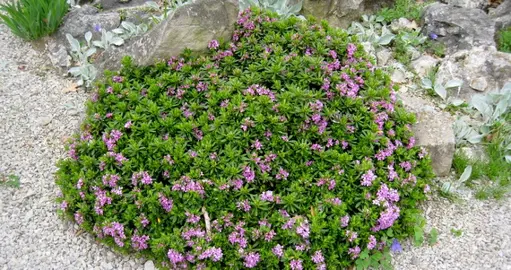
Despite there being over 70 different species of Daphne, only a select few are grown as landscape and garden options. They tend to fall into main categories:
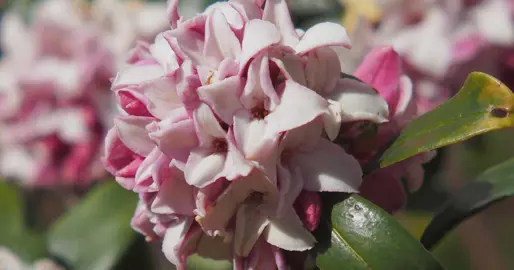
The lifespan of a Daphne can vary depending on the variety, the climate, and the growing conditions. However, most Daphne plants have a lifespan of 5-10 years. Some varieties, such as Daphne bholua, can live for up to 20 years.
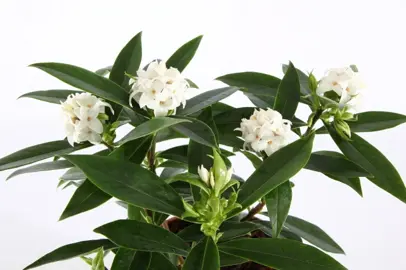
Daphne can be expensive as they are slow-growing and more difficult to propagate than most species. This means it takes longer to produce a saleable plant and results in higher production costs for growers. Larger plants will always be more expensive as they can take an additional year to grow in the nursery.
Growing a Daphne hedge takes some thought and planning to ensure you get what you are after. Factors such as the plant spacing, desired height, and variety are all important considerations. The Plant Company have produced this series of articles to provide advice for trimming Daphne hedge and pruning Daphne so you can manicure your plants with confidence and success.
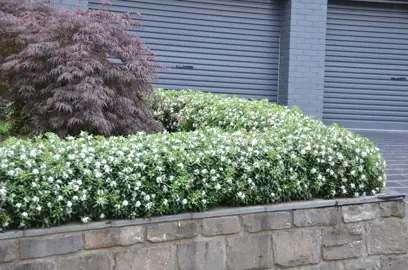
Daphne 'Eternal Fragrance' make beautiful hedges and are more often grown as an informal hedge (i.e., minimally trimmed). The plants are usually spaced 50-70 cm apart for hedging. Remember that the number of plants for a hedge 5 m long and spaced 50 cm apart is 11 (not 10) as you need one at both the start and end.
If a narrow and dense hedge is required, the trimming will need to start early. That is, start clipping the sides and top with secateurs well before it reaches the desired height and width. Each time a stem is cut, the buds on the remaining stem will sprout. Each stem will now end up with two or more shoots growing from it. Repeatedly doing this forces the plant to keep branching and therefore makes the plant denser. Once the hedge is getting close to the desired width, the trimming regime can move to an annual basis and this is usually down after flowering. It is generally trimmed only lightly as the plants are not fast growing.
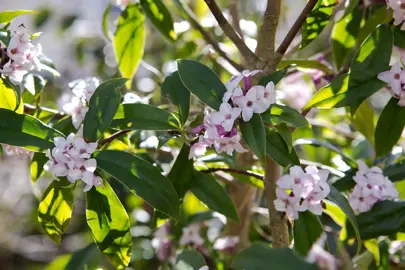
Daphne are slow-growing shrubs and need little in the way of pruning. The occasional trim to remove broken branches or branch that looks out of place is all that it generally needed. That said, if you want to trim a plant, do it after flowering and remove as little foliage as possible as you shape the plant. Heavy pruning can cause the plant to dieback, which is far from desirable. The Plant Company recommends erring on the side of caution with any Daphne trimming.
Caring for Daphne plants is about making sure the plants are thriving. Our plant care articles provide the necessary details to give you the greatest chance of success. Afterall, there is nothing worse than investing in the plants, putting the effort into planting them, and then having them fail. Therefore, follow our advice and give yourself the best chance of success.
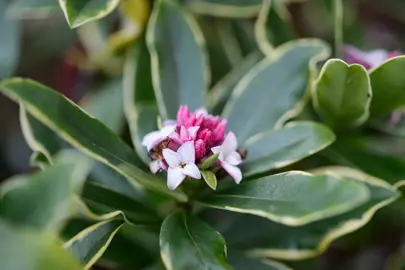
Caring for Daphne is all about knowing what to do in each season. Even though they are low maintenance plants, they will benefit from the attention you provide.
Winter is the perfect time for mulching around your plants. Organic matter such as compost or sheep pellets should be spread liberally around the plants and then overlaid with a mulch. The Plant Company has two very good options for mulch. The first is coco fibre matting which is made from the husks of coconuts. It breaks down to become part of the soil within two years. The second is the black plastic matting which will last 20 years or more. In both instances The Plant Company recommend stones, bark chip, or other similar products be spread over top of the mulch for aesthetic purposes. The Plant Company do not recommend adding fertiliser during winter as this is better applied in spring so less is wasted. However, adding organic matter is quite okay.
Spring is the perfect time for fertilising the plants as they start to bounce into life and flower buds begin to open. The Plant Company has fertilisers which have been specially blended for different plants and in this instance, our fertiliser for acid loving plants will give them the correct boost and keep them fed for 12-months. A suitable alternative is organic fertiliser which will also keep them well fed but it will require a secondary application in autumn.
Summer is when the plants need regular watering and this should be undertaken daily on the hottest days. Plants that are establishing need particular attention as their root system will not have penetrated deep enough to secure consistent moisture yet. The Plant Company recommends a deep watering and then allow the plants to dry out for 2-3 days (or more) before the next watering.
Caring for Daphne in autumn is all about finishing any trimming and keeping the plants healthy. Foliar feeding using a liquid fertiliser can be undertaken during spring, summer, and autumn if you have time but this is not essential if solid fertiliser and/or good amounts of organic matter have already been applied. If you think the plants need an extra boost or have some yellowing, however, a liquid fertiliser won’t hurt.
Check plants for any pest or disease issues during spring, summer, and autumn. If anything is looking a little bit unusual at any time of year, refer to our section on dealing with issues for a solution.
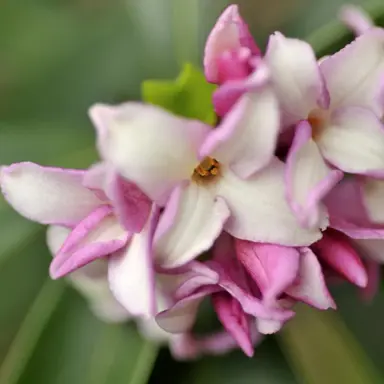
Aged flowers can make Daphne plants unsightly at times. It really is a matter of choice as to whether you remove the spent flowers or not as it won’t have any real impact on the plant either way. The Plant Company does, however, recommend that spent flowers are removed on Daphne maintained in containers to improve their aesthetics.
Many experienced gardeners will talk about a Daphne plant that dies for no apparent reason. They simply put it down to “that’s what happens with Daphne”. However, The Plant Company takes a different view. That is, there is always a reason why a plant dies, be it Daphne or any other plant. Our articles provide valuable insight so you can understand why the plant died and hopefully avoid future issues.
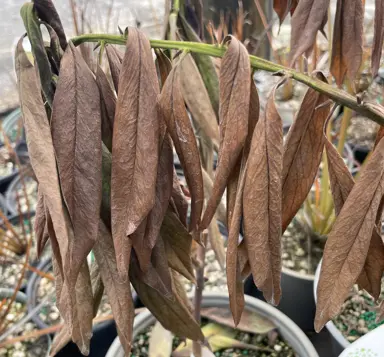
When a Daphne plant is grossly underwatered, it develops brown and crispy leaves. This is preceded by young stems wilting and flowers falling prematurely. Dig down into the soil and check to see how dry it is, and water accordingly.
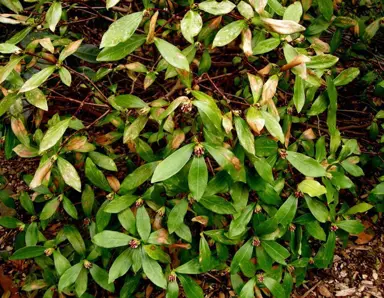
Daphne plants are generally quite resistant to diseases. However, there are a couple of things that can trouble them:
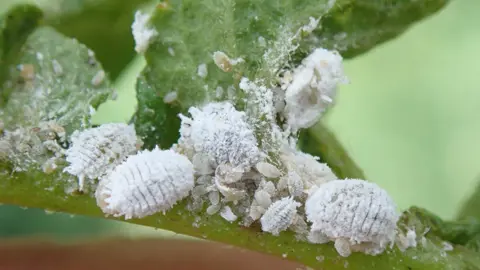
A few pests can reside on Daphne plants:
If you notice any of these pests on your Daphne, it is important to treat them early to prevent them from spreading. You can control them with an insecticidal spray that specific to each pest. Always be sure to follow the instructions on the label carefully.
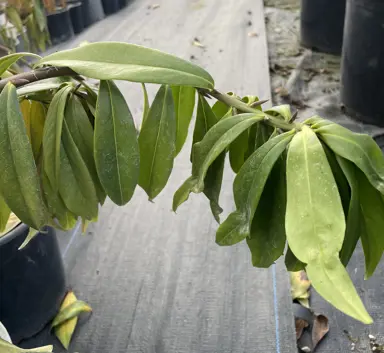
If the leaves on a Daphne plant are wilting, even several hours after watering, it is highly likely a disease is impacting the roots. Daphne are highly susceptible to root disease, which often sets in after the plants have been exposed to an extended period of constant wetness either through over-watering or excessive rain. In such circumstances, the root hairs can be damaged and enable the entry of the soil borne pathogen. This pathogen causes more root hairs to dye, which reduces water uptake by the plant, and the characteristic wilting.
There are two solutions to this issue. The first is to reduce the likelihood of the disease by planting the Daphne on a well-drained soil. The Plant Company recommends planting it on a low mound so the roots are never exposed to prolonged wet. The second solution is to stop all watering on the plant. There is a 30% chance that it will start to sprout new shoots from the base and regrow. NB: an older plant is less likely to resprout than a younger plant.
Soil drench fungicides are an option for controlling the disease, but this option is generally considered preventative than curative.
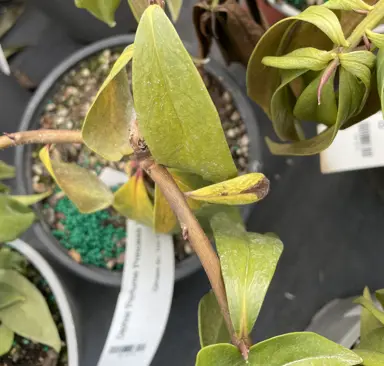
If your Daphne plant's leaves are turning yellow or beginning to droop, it's a sign that the plant is overwatered. Daphne varieties are very sensitive to improper watering conditions. Ensure that the plant has plenty of drainage (either naturally in your landscape or in its container) and cut back on waterings to allow the soil to dry slightly.
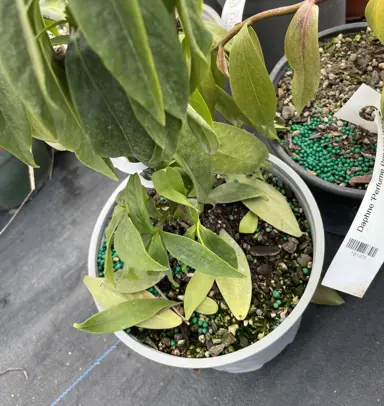
Leaves falling from your Daphne plant is likely to be caused by overwatering. Persistent over-watering damages the root hairs and reduces their ability to take up water and nutrients. Reduce the waterings and check that the soil is well-drained.
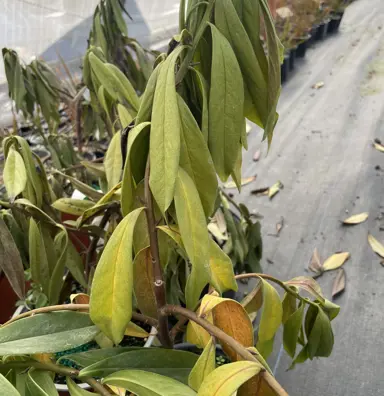
Daphne Sudden Death Syndrome (DSDS) is a real threat to Daphne plants, especially those grown in nurseries or cultivated landscapes. It's a nasty fungal disease caused by the soilborne pathogen Thielaviopsis basicola. This fungus attacks the roots of the Daphne, leading to rapid decline and death of the plant.
Watering Daphne plants correctly is an important part of growing these amazing shrubs. Importantly, making sure they get enough without being over-watered is paramount.
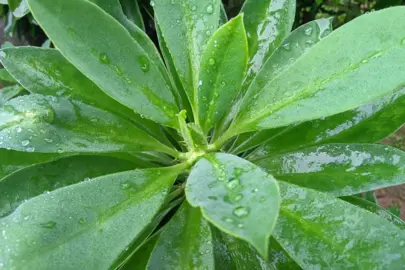
Daphne are lush plants and this foliage requires good soil moisture during dry periods to stay fresh and keep growing actively. The Plant Company advises generous watering daily or every second- or third-day during summer. If the young stems start to droop, you need to water immediately as this is a sign of severe moisture stress and is not normal. Plants should be watered thoroughly in the morning for water conservation purposes. During cooler times of the year watering will usually only be required during dry periods or for a short period after planting.
Over-watering can be a problem with most plants including Daphne. Too much and the plants will develop root rot issues and slowly deteriorate. The first tell-tale sign of over-watering is a yellowing of the leaves. If the plants are on a well-drained site or growing in well-drained growing media this should rarely be an issue. Clay soils tend to be poorly drained and can result in the equivalent of over-watering. For this reason, The Plant Company advise against planting Daphne on such soils unless drainage issues are addressed.
Planting Daphne and getting it to grow well is generally easy when you get a few of the basics right. This involves planting them in the right soil type, choosing the most ideal planting position, and ensuring the plants have the essentials to thrive. The Plant Company has the right advice to give you the greatest chance of success when growing a Daphne.
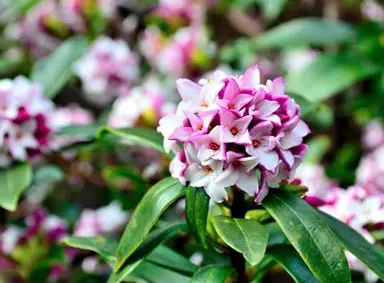
Daphne plants can be a bit tricky to grow in New Zealand, but they are definitely rewarding if you can get them established. They are known for their beautiful flowers and amazing fragrance, especially during the winter months. The main challenge with daphne is that they prefer cool, well-drained, acidic soil. They don't like their roots to be disturbed or to be overly wet, so it's important to be careful when planting them and with watering. They also don't do well in extremely dry conditions. Always err on the light side with watering and undertake a deep watering and allow the plants to “dry out” before watering again.
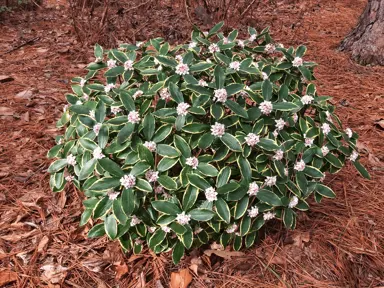
Choose a full sun or partial position with good drainage and moderate shelter for your Daphne plant. The hole should be dug to at least 50-75% deeper and wider than the container the plant is currently growing in. A good planting spade makes this job a lot easier. The Plant Company recommends incorporating compost or sheep pellets into the soil to provide additional organic material, but this is not essential. Do not put fertiliser in the bottom of the hole, rather spread that on the soil surface after planting, and preferably do this when the plant is actively growing in spring.
Remove the plant from the container it is growing in by either pulling it free or by cutting the bag. We recommend cutting the bag, especially for larger grade plants, to minimise any chance of damaging the roots. The Plant Company does not advise cutting through roots, even if the plant is rootbound, as that injures the plant. Our article, Managing Rootbound Plants explains this in more detail. Moreover, Daphne do not like root disturbance and any activity can cause the plant to “shutdown” for a period.
Now place the plant in the hole and make sure it is level with the soil surface before filling in around it. If it is sitting above the soil surface, dig more out. If it is below, put in more soil and retest the level. Once the plant is set level with the soil surface, add more soil gradually and firm it around the plant using gentle pressure from your fingers as you go. Scatter fertiliser for acid loving plants across the soil surface after planting and the give the plant a good watering. If the plant is taller than 30 cm you might want to consider staking it to give it a bit of extra support and use tree ties for secure and appropriate holding.
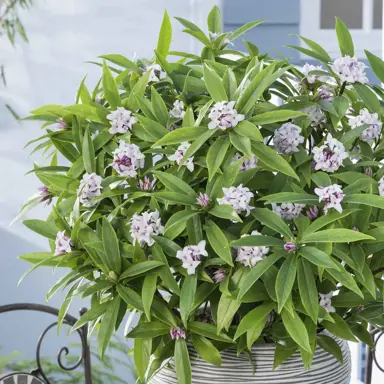
To pot (or repot) a Daphne plant, start by removing the plant from the container it is growing in by either pulling it free or by cutting the bag. The Plant Company recommends cutting the bag or container, especially for larger grade plants, to minimise any chance of damaging the roots. If the roots have been growing in a circle or are all bound up you can tease them apart if you want but this is not essential. Similarly, you don’t need to remove any of the growing media. The Plant Company does not recommend cutting the roots, even if the plant is root-bound as this offers no benefit. This is explained in our article, Managing Rootbound Plants.
Choose a pot that is no more than twice the size of what the plant is currently growing in and that has plenty of drainage holes in the bottom. Fill the bottom of the pot to about 1/3 of the way up with potting mix. Do not use soil or compost when growing plants in a container and do not add fertiliser. The Plant Company potting mix has all the nutrients required to sustain the plant for the next 12 months. Place the plant in the pot and add more potting mix. Firm this around the plant using gentle pressure, then water well. They should be watered twice a week during hot weather and weekly or fortnightly during cooler periods.
The key to having an amazing Daphne in a pot is to water it only when the top 25 mm of soil is dry, keep it away from cold drafts, and feed it with indoor plant fertiliser in spring and again in autumn.
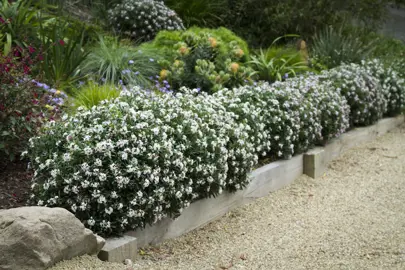
The best place to plant Daphne is in a well-drained spot with a soil that is rich in fertility and is slightly acidic. They can tolerate a variety of climates, but they prefer full sun or partial shade position that is sheltered from wind. If the soil becomes waterlogged for even a short period of time, they will often die. Therefore, pay particular attention to watering as well as their location.
Propagating Daphne is a relatively straightforward process when you have the right advice. Our articles give you the best chance of doing this successfully and efficiently.
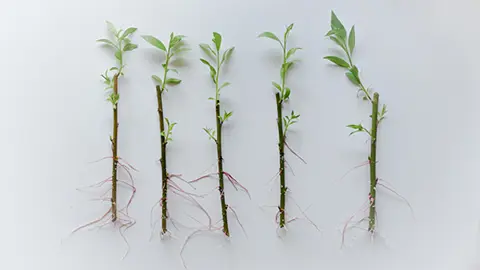
Daphne are propagated from stem cuttings. Semi-hardwood cuttings are usually taken from autumn until mid-spring. A stem about 8-10 cm long is trimmed into a cutting using secateurs with 2-3 leaves at the top and just below a node. The cutting is dipped in rooting hormone then inserted into propagation growing media. The tray of cuttings is placed under mist with bottom heat also applied. The cuttings will have taken root inside of four weeks as a general rule.
Whether you need assistance finding the plant you’re looking for or you simply want to know more about who we are and what we do, we invite you to get in touch with us today. A member of The Plant Company team will get back in touch as soon as possible.

